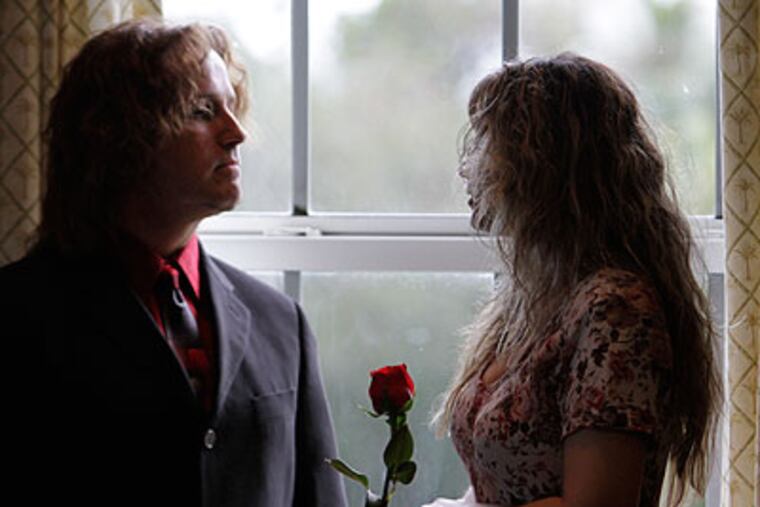Experts in Philly describe mysteries of polyamory: When one lover isn’t enough
You think a romantic relationship between two people is hard? Try polyamory. A panel of experts at the American Psychiatric Association meeting in Philadelphia last week said that open relationships between more than two people can work, but it requires a lot of talk about rules, boundaries, and time spent with various lovers.

You think a romantic relationship between two people is hard? Try polyamory.
A panel of experts at the American Psychiatric Association meeting in Philadelphia last week said that open relationships between more than two people can work, but it requires a lot of talk about rules, boundaries, and time spent with various lovers.
William Slaughter, a psychiatrist in Cambridge, Mass., who has been treating polyamorous patients for about five years, said they need to have very good communication skills and be especially good at "mentalizing" or understanding others' emotional reactions. He and Richard Sprott, a psychologist at California State University East Bay, and Elisabeth Sheff, a sociologist who recently left Georgia State University, talked about what to expect from polyamorous patients. Such patients often complain that they have to spend too much time educating their therapists, Slaughter said.
The session was a lesson in vocabulary words you're unlikely to see on the SAT. Word one: polyamory itself. It means having more than one intimate sexual and/or emotional relationship at the same time with the knowledge and consent of everyone participating. It's different from swinging, which involves brief outside sexual relationships that are not emotionally intimate.
The most common presentation, the panel said, is a couple that considers their relationship primary, while each may also have secondary relationships with other people. Sometimes all the relationships are considered equally important or all secondary.
Sheff said she knows of one group of seven, but that's unusual. "When they get larger than quads, they're a moresome," she said.
Jealousy is, of course, a frequent problem, but the polyamorous also have words for an opposite concept. Being happy that another relationship is enriching your partner's life is known as compersion or frubbliness.
Enough vocabulary for now.
Sheff and Sprott believe polyamory is increasing. Sprott said younger generations are less insistent on monogamy than their parents. He cited research that found that 29 percent of lesbian couples, 29 percent of cohabiting straight couples, and 47 percent of gay couples are not monogamous. Among married couples, 23 percent of men and 19 percent of women cheat at some point in the marriage. He said there is no way to know how common polyamory is.
Sheff, who has been studying polyamory for 15 years, said traffic on websites for the poly community and the number of poly groups have been increasing.
The panel said there is ongoing debate about whether polyamory is a choice or a sexual orientation. Some people float between monogamous and polyamorous relationships.
She and Sprott said the poly community tends to be white and well educated. About half say they are bisexual and 30 to 40 percent are into BDSM (bondage, discipline, sadism, masochism), Sprott said. He said both the men and women tend to have unusually high testosterone levels and be extroverted and high in what psychologists call sensation-seeking.
Sheff has studied children in polyamorous families. In her small sample, the "kids tend to be in great shape." These families often aren't obvious to the mono world. They look like a couple whose good friends come over a lot or people who are good friends with their exes. Most are discreet about sex, so the kids aren't confronted by it and neither are their friends.
Sheff said the children say they like having extra adults in their lives. There's always someone to drive them somewhere or help with homework. "A number of them expressed pity for children who only have two parents," she said.
The important point for therapists, she said, is that polyamorous families are "not definitionally pathological." While they don't follow conventional morals, they do establish clear ethical codes that emphasize honesty and treating others well.
When Sheff said she thought laws should recognize parental rights for multiple people in such arrangements, one audience member pronounced that idea "not politically viable."
Another expressed skepticism that the children were not influenced by their parents' unorthodox sexual behavior.
Slaughter said people in the poly community come to him for the same reasons as other patients. Some extra issues include secret affairs, coercion, grudging consent, the opening and closing of marriages, and fears about child custody. A particularly emotional time is when a couple decides to enter the poly community together, he said. They have to work out new boundaries. They ask: "How much time do you spend with me? How do I know you love me?"
Asked about sexually transmitted diseases, the panel said this issue is probably discussed in more detail in the polyamory community than among other groups. People may agree on complex sexual rules, including "fluid bonds" that spell out whom they'll have sex with without condoms.
— Stacey Burling